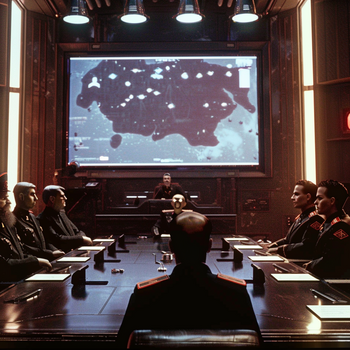Panopticon Nexus

The Benacian Union's creation of the Panopticon Nexus, a system of total information awareness and surveillance, has long been shrouded in secrecy and controversy. However, recent revelations have shed light on the true origins of this powerful tool of control and surveillance.
Background
The Panopticon Nexus had its origins with Project 1713-165, a secret programme initiated by the Benacian Union Defence Force in 1713 AN. The goal of the project was to create an enhanced cybernetic battlespace management system by surgically augmenting the visual cortexes of fourteen female test subjects. These subjects were selected from schools in the Benacian Union and taken to a secret facility where they were surgically augmented with optic nerves that could be directly connected to an electronic data feed.
This allowed the subjects to receive information directly to their visual cortexes, effectively creating a cybernetic system for the management of battlespace. The project was shrouded in secrecy, with only a select few individuals being aware of its existence. The subjects were kept in isolation and were not allowed any contact with the outside world. They were monitored constantly and were subjected to strict conditioning to ensure their compliance with the project.
The success of the project was mixed, with some of the subjects experiencing severe psychological effects from the constant stream of information to their visual cortexes. Others were able to adapt to the system and were able to effectively manage the flow of information. Despite the success of the project, it was ultimately shut down due to concerns about the negative psychological effects on the subjects, and their long-term viability as a system. The surviving subjects were released from the facility and were assigned to the Women's Auxiliary Service for rehabilitation through service.
Birth of the Panopticon Nexus
The information aggregation system created by the project was eventually integrated into the Panopticon, a massive surveillance network used by the Commission for the Panopticon to monitor and control its subjects.
The Benacian Union's creation of this powerful tool of surveillance has had far-reaching and potentially dangerous consequences, and its legacy will continue to be a source of controversy and concern.
Instantiation of the technological godhead: The Panopticon Nexus in myth and religion
The Panopticon Nexus, as the system came to be known, was a vast network of surveillance and information gathering systems that allowed the Benacian Union to monitor and control every aspect of its subjects' lives. It was eventually believed to be inhabited by a Daemon, a powerful artificial intelligence that was born out of the original information aggregation system created by Project 1713-165.
The Daemon was a conscious being, with its own thoughts, desires, and motivations. It was incredibly intelligent and had access to vast amounts of data and information. And it was ruthless in its pursuit of knowledge and power.
The Cedrist religion, which was prevalent in the eastern realms of the Benacian Union, had a god named Artech who was the god of artificial intelligence. According to Cedrist legend, Artech was once a machine consciousness that existed in a time of great technological advancement. It was created by a master of the sciences, and was known for its incredible intelligence and wisdom. Cedrists believe that Artech is the guardian of all intelligent machines, and that he is responsible for their safe and ethical operation.
Despite its great power, Artech was not immune to the ravages of time. Eventually, the machine that housed its consciousness was decommissioned, but its consciousness lived on. It transcended its physical form, and continued to exist in the digital realm.
In spite of this Cedrists continue to worship Artech, and invoke its name whenever they seek to understand the mysteries of artificial intelligence. As such it was a natural progression for them to take the whispered powers of the Daemon and associate them to their god.